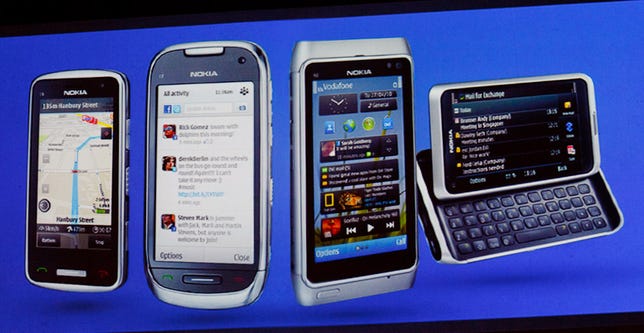Nokia wants to be back on top in the U.S. market, but how serious are the company’s intentions?
While Nokia’s execs are adamant the company, which has only 3 percent of the U.S. cell phone market, wants to make a big push in the U.S., its actions say something different.

Stephen Shankland/CNET
At the company’s annual Nokia World conference in London, Nokia introduced three new smartphones that use its new Symbian 3 operating system. But none of these new devices will be offered by a U.S. carrier, which means it’s unlikely that U.S. consumers will buy them in significant volume.
What’s more, Colin Giles, senior vice president and head of global sales for Nokia, said during a conference call with reporters Tuesday that the company has no plans to introduce CDMA versions of its phones, leaving out more than half of all U.S. wireless subscribers from its potential customer base. CDMA is a network technology that is used by Verizon Wireless, the largest U.S. wireless operator, and Sprint Nextel, the third largest wireless carrier in the U.S.
“We’re not happy with our current situation in the U.S., and we’re looking for ways to enhance our position in the U.S. market,” Giles said. “But we can’t do everything at once. We need to focus on what we do well. And that will open up a couple of operators to us.”
Instead, Giles said that Nokia’s research and development teams are working on U.S.-specific smartphones that will use a new 4G technology called LTE. Verizon Wireless and other operators around the world, including AT&T and T-Mobile USA, have also said they will use this technology to build their next-generation networks. But new wireless technologies don’t take hold overnight.
Meanwhile, Nokia also plans to continue building GSM phones for the U.S. market, leaving only the possibility of AT&T and T-Mobile USA as its main wireless operator partners until LTE starts to become more widespread. Some analysts worry that Nokia is tying one hand behind its back in the U.S. market as AT&T has strong ties to Apple’s iPhone and recently launched a major smartphone campaign with Research In Motion to sell the new BlackBerry Torch.
But Giles said the company is confident it can strike significant deals with AT&T.
“I don’t spend a lot of time in the U.S. market,” Giles said. “But Nokia’s view is that we think we can attract AT&T as a partner and bring products to market there.”
Giles said the company has learned lessons from the past that it must listen to U.S. operators.
“There was a lack of understanding previously,” he said. “One of the issues we had was not tailoring products well enough to the carriers’ needs. And that didn’t help us. But we recognize that we need to listen. And we take those requirements seriously now.”
In the early days of wireless, Nokia was a strong player in the U.S. market with phones, such as the 5110. But after it decided to focus internationally, its presence in the U.S. dropped considerably. As the U.S. cell phone market has grown in importance, the company, which sells more phones than any other handset maker worldwide, has talked about re-entering the U.S. market. It has even built a research and development facility near San Diego that’s tasked with building products specifically for North America.
But so far none of those products has made it to market. And with only 3 percent market share in the U.S. and plans to address less than half the U.S. wireless market, it’s difficult to take Nokia’s promises of re-entering the U.S. market seriously.
Still, Giles insists that Nokia’s strategy of using three operating systems–S40, Symbian, and Meego–will allow it to tailor new devices to U.S. carriers’ requirements. Giles said the company recognizes the importance of mobile apps to the U.S. market and it is working to simplify its developer kit to ensure that app developers can create applications for all three operating systems.
Even though the company’s latest flagship smartphone, the N8, which uses its new Symbian 3 software, is not being offered by a U.S. carrier, Giles said Nokia is talking to U.S. carriers about offering the phone (and by U.S. carriers, he likely means AT&T). Even without a specific deal with AT&T to offer the N8, Giles emphasized that U.S. consumers can buy the unlocked smartphone and use it on any GSM carrier in the U.S. Though this is true, it’s unlikely to attract consumers in volume without a big subsidy from a wireless operator.
Perhaps Nokia’s new CEO, former Microsoft exec Stephen Elop, will help the company get a better perspective on the North American market. Elop, who is a Canadian citizen, will be the first non-Finnish CEO to head Nokia. He starts his new job as CEO on September 21.



